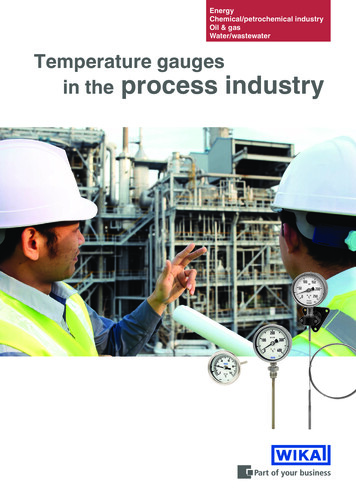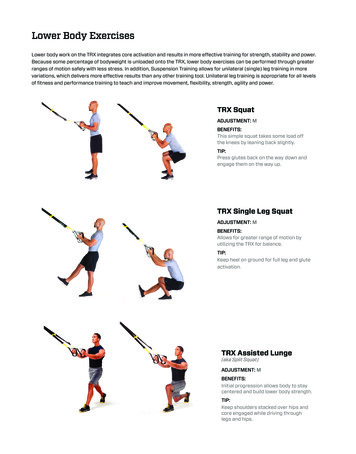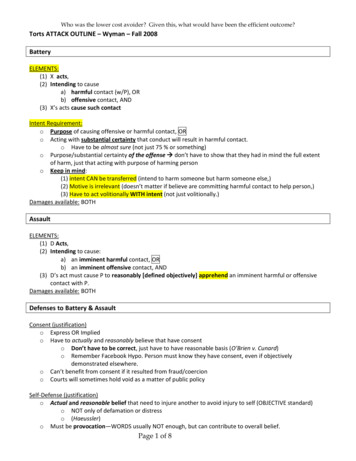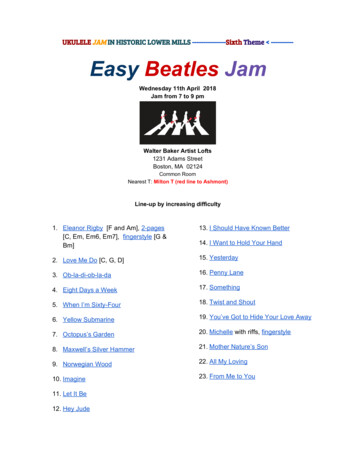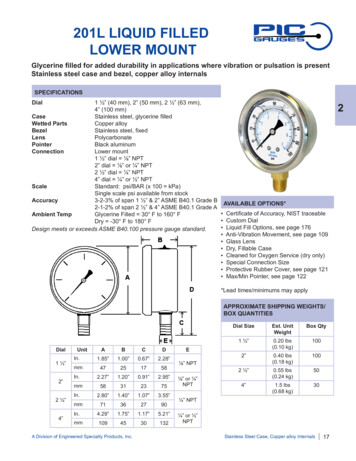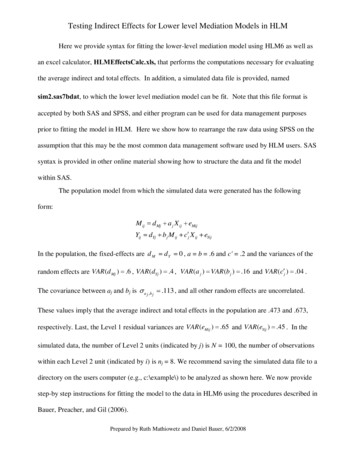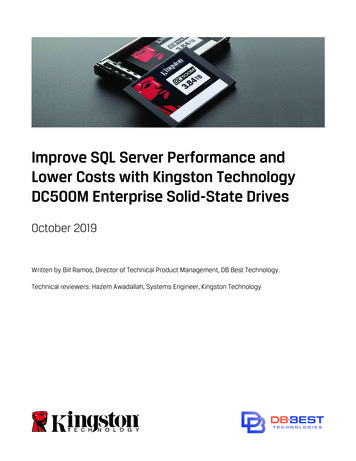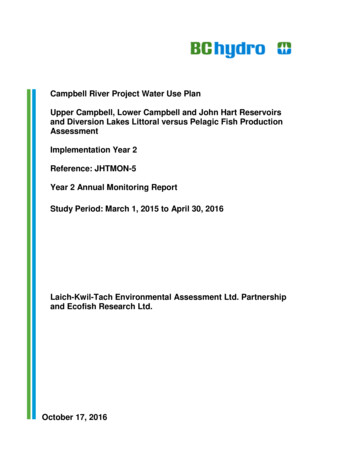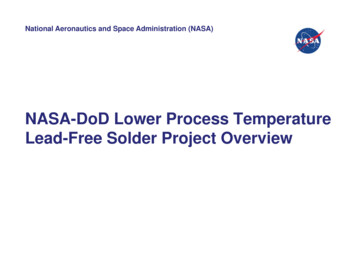
Transcription
National Aeronautics and Space Administration (NASA)NASA-DoD Lower Process TemperatureLead-Free Solder Project Overview
National Aeronautics and Space Administration (NASA)Does NASA care?YESNASA Policy Directive {NPD 8730.2C}NASA Parts Policy ATTACHMENT A: Criteria to Mitigate Risks Associated withLead-Free Solder and Surface Finishes:a.Tin-Lead (Sn-Pb) based solders and Sn-Pb part surfacefinishes (minimum 3% Pb by weight) shall be used wheneverpossible for the assembly of electronics hardware intended forNASA spaceflight and critical ground support applications(Requirement). The use of lead-free (Pb-free) solders or Pb-freeSn-based part surface finishes may be allowed when justified bytechnical need, but only by exception and with the approval ofthe parts, materials, and processes control board for the NASAproject or an equivalent authority.
National Aeronautics and Space Administration (NASA)ATTACHMENT A: Criteria to Mitigate Risks Associated with Lead-FreeSolder and Surface Finishes:b.A Lead-Free Control Plan (LFCP) shall be developed that meets the requirements setforth in GEIA-STD-0005-1, including special design considerations, manufacturingprocess controls, test and qualification requirements, quality inspection and screening,marking and identification, maintenance and repair processes, and other steps taken tomitigate risks and to ensure the reliability of hardware for the intended application(Requirement). Control plans may be project unique or apply to multiple Center projects.GEIA-HB-0005-1, GEIA-HB-0005-2, and the NASA Tin and Other Metal Whisker Website, http://nepp.nasa.gov/whisker, may be consulted to obtain information related to theproblems lead-free electronics present. In addition to pure tin, other metals such as purezinc and pure cadmium may result in harmful metal whiskers. Identification of controlsrelated to other metal surface finishes is determined at the NASA Center level.c.A control plan shall be developed to reduce the harmful effects of tin whiskers thatmeets Level "2C" requirements set forth in GEIA-STD- 0005-2 (Requirement). Lessstringent control plans meeting Level "2B" are allowed in exceptional cases with theapproval of the parts, materials and processes control board or an equivalent authority.Control plans may be project unique or apply to multiple Center projects.
National Aeronautics and Space Administration (NASA)ATTACHMENT A: Criteria to Mitigate Risks Associated with Lead-FreeSolder and Surface Finishes:d.The use of Pb-free ( Note: The introduction of lead containing solders presents anemployee exposure hazard that is regulated under OSHA (29 CFR 1910.1025). Thisregulation requires baseline hazard assessments be performed for any operation (e.g.,generation of metal dust or fume) that may result in employee exposure to lead, andadditional medical surveillance, employee training, monitoring, and exposure controlrequirements when a positive exposure assessment is made. Exposure risk, based onpast assessments, is very low for piecework operations and moderate for assembly lineor classroom instruction based on work volume.Regardless of the exposure assessment outcome, all affected employees are required tocomplete Hazard Communication training for Chemical Users and individual employeereview of 29 CFR 1910.1025, Appendix A, "Substance data sheet," and B, "EmployeeStandard Summary." This training may be provided at the supervisory level by employeereview of the referenced appendices available from Environmental Health. Additionally,all soldering workstations will require use of local exhaust ventilation (fume extractors)and regular cleaning to prevent buildup of lead residue on work surfaces.
National Aeronautics and Space Administration (NASA)MSFC-STD-3012, Electrical, Electronic, andElectromechanical (EEE) Parts Management andControl Requirements for MSFC Space Flight Hardware5.3.2.1 Destructive Physical Analysis (DPA) Requirements for DPA shall be as designated in Tables V, VI, or VIIfor Grades 1, 2, and 3 EEE parts. DPA sample size shall be inaccordance with MIL-STD-1580 unless otherwise specified herein.Any lot of parts not meeting the DPA acceptance criteria shall not beused in equipment without focal point EEE parts organizationapproval. In addition, all DPA samples from non QPL/QML/QPD manufacturedEEE part lots shall be tested internally and externally for pure tinas defined in Section 5.4.4.1 herein.5.4.4 Hazard Avoidance Grades 1, 2, and 3 EEE parts shall comply with the programrequirements for hazard avoidance (e.g. NSTS 1700.7, NASA-STD6016, or equivalent program document), Table IV, and the followingsubparagraphs. All EEE part grades, including Grade 4, shall avoidthe prohibited materials listed in Table IV, Hazard Avoidance.
National Aeronautics and Space Administration (NASA)5.4.4 Hazard AvoidanceTable IVTable IV. Hazard Avoidance
National Aeronautics and Space Administration (NASA)5.4.4.1 Pure Tin Finish Avoidance Any EEE part where pure tin finish is not precluded by themilitary QPL/QML/QPD, or specification control document,shall be tested internally and externally for pure tin as definedin Table IV. The minimum sample size shall be two devices ortwo percent of the lot, whichever is greater, to a maximum offive samples. If parts fail to meet the 3% lead by massrequirement, the preferred method to mitigate the risk frompure tin is to solder dip the expose tin finish in accordancewith GEIA-STD-0006, Requirements for Using Solder Dip toReplace the Finish on Electronic Piece Parts. If the solder dipprocess is not practical, the risk from pure tin shall bemitigated in accordance with IPC J- STD-001ES, SpaceApplications Electronic Hardware Addendum to IPC J-STD001E, Requirements for Soldered Electrical and ElectronicAssemblies, Clause 0.1.6, Use of Lead-Free Tin.
National Aeronautics and Space Administration (NASA)Table V. Standard Parts and SelectionPreferences for Grade 1 Note 6: The MIL-PRF-55681/1 style CDR02 ceramic chipcapacitors shall not be used in Grade 1 applications. Thisparticular chip has a large length to width ratio (0.18" x 0.05")which makes this chip highly susceptible to cracking as aresult of board flexing. The use of MIL-PRF-55681 ceramic chip capacitors withTermination Style "W" or "Y“ is PROHIBITED. Terminationstyle "Y" is pure tin and termination style "W" gives themanufacturer the option to use either pure tin or a tin-leadalloy as a termination finish. Note 19: 100% screening shall be performed per MIL-PRF3098 Table I Product Level S, including the following testinspections: PIND testing, radiographic Inspection, andPercent Defective Allowable (PDA) of 5%. Pure tin shall beprohibited as a final finish.
National Aeronautics and Space Administration (NASA)NASA-DoD LEAD-FREE ELECTRONICSPROJECT:Lower Process Temperature Pb-FreeSolders
National Aeronautics and Space Administration (NASA)Project Partners NASA MSFC JPL KSC Navy Air Force Army DMEA Sandia HarrisNorthrop GrummanHoneywellLockheed MartinHamilton SundstrandRaytheonPWB Interconnect SolutionsUniversity of MarylandForesite CelesticaComDevMedtronicGeneral DynamicsGeneral AtomicsGEBoeingBAE SystemsGarminRockwell Collins
National Aeronautics and Space Administration (NASA)Previous Efforts The NASA-DoD consortia group has lead the industry in the understanding oflead-free bismuth containing solder alloys The JCAA/JGPP Phase I investigation effort, the consortia included theNCMS lead-free bismuth containing solder alloy as their 1997 work hadshown it had some promise as an alternative candidate solder alloy system fortin/lead solder. The JCAA/JGPP Phase I investigation results {2006} demonstrated that thelead-free bismuth containing solder alloy had very good performance in harshenvironmental testing but it also had some compatibility issues to be furthercharacterized. For many components SACB solder joints were at least as reliable as the SnPb controls during thecombined environments and thermal cycling tests. (Exceptions were when SACB was contaminatedwith SnPb) For SACB solder alloy, SnPb contamination usually has a detrimental effect on reliability. The degreeof degradation of SACB solder joint reliability appears to be inversely proportional to the amount ofSnPb contamination in the solder joint. Therefore, soldering with SACB solder requires appropriatefactory management to eliminate lead contamination. Pb contamination must be better understood and controlled if SACB solder is to be utilized. The levelof control of Pb contamination required when soldering with SACB may not be available to servicecenters and might pose an unacceptable risk to high-performance systems. If Pb contamination is notcontrollable, that may preclude the use of SACB solder on some or all aerospace and defenseelectronics.
National Aeronautics and Space Administration (NASA)Previous Efforts The NASA-DoD Phase 2 investigative effort further characterized lead-freesolder alloy systems by extensively looking at rework/repair characteristics. The NASA-DoD Phase 2 investigative results {2011} were extensively used bysolder alloy producers (i.e. Indium, Senju, etc.) and electronic productmanufacturers (i.e. Honeywell, Boeing, Rockwell Collins, Celestica, etc.) as alaunching pad for their own investigative efforts on how the lead free bismuthcontaining solder alloy could fit into their specific electronic product designs. The effects of copper dissolution must be taken into consideration for any lead-free solderassembly processes.For this project there was no significant difference in solder joint reliability between the twoboard finishes (ImAg and ENIG) tested.Under high-stress mechanical and thermal conditions, SnPb generally outperforms Pb-free.For low stress conditions, Pb-free generally outperforms SnPb. One exception to this trend isthe mechanical shock test results. These results are similar to the JCAA/JGPP Lead-FreeSolder Project results.The results of this study suggest that for some component types and environments, Pb-free soldersare as reliable as the currently used eutectic SnPb solder. This study also demonstrates that withother component types and environments, the Pb-free solders fail before the SnPb control.
National Aeronautics and Space Administration (NASA)Need The NASA-DoD Lead-Free Electronics Project confirmed thatpad cratering is one of the dominant failure modes that occurin various board level reliability tests, especially under dynamicloading harsh environments. Pad Cratering is a latent defect that may occur duringassembly, rework, and post assembly handling and testing. Pad cratering cannot be identified during back-end-of-line incircuit test (ICT) or functional circuit test (FCT) protocols andposes a high reliability risk under mechanical and thermomechanical loading.
National Aeronautics and Space Administration (NASA)Objective Solder alloys with a process temperature in the range of 220 Cto 226 C will be evaluated for solder joint reliability. Several ternary tin-silver-bismuth (SnAgBi) and quaternary tinsilver-copper-bismuth (SnAgCuBi) lead-free solder alloys haveshown great mechanical and thermo-mechanical reliability inpreviously completed projects {National Center forManufacturing Sciences (NCMS) and JCAA/JGPP Lead-FreeSolder Project} and new studies {GJP Lead-Free Avionics andCelestica} Sn 3.4Ag4.8Bi Sn2.25Ag0.5Cu6.0Bi Sn2.0Ag7.5Bi
National Aeronautics and Space Administration (NASA)Why this is Important The proposed NASA-DoD Phase 3 investigation is fundamentally different thanother industry activities because the consortia is proposing to conduct testingthat is applicable to the entire electronics industry in an unbiased, openarchitecture format that will provide further understanding of bismuthcontaining solder alloy systems in relation to current tin/lead and SAC solderalloy soldering practices/procedures. It is anticipated that the electronics industry will utilize the NASA-DoD Phase 3investigation results as a springboard for further industry solder alloyinvestigative activities in a similar fashion to what occurred with theJCAA/JGPP and NASA-DoD Phase 2 investigation results.
National Aeronautics and Space Administration (NASA)Test Vehicle DesignDrop Test Board – Final
National Aeronautics and Space Administration (NASA)Test Vehicle DesignVibration / Thermal Board – Final
National Aeronautics and Space Administration (NASA)Solder Alloy Selection SnPb baseline 183oC SAC305 baseline 217 – 219oCLower process temperature LF solders 91.8Sn 3.4Ag 4.8Bi {Indium Corporation} Melting Temperature 206 – 216oC Commercial use; consumption volume unknown Sn2.25Ag0.5Cu6.0Bi {Indium Corporation} Melting Temperature 205 – 215oC Commercial use; consumption volume unknown Sn2.0Ag7.5Bi {Indium Corporation} Melting Temperature 190 - 215oC Commercial use; consumption volume unknown
National Aeronautics and Space Administration (NASA)Materials SelectionLaminatesBaseline – Isola 370HRAlternative - Isola 408HRBoard FinishesPrimary board finish: Immersion silver (ImAg)Limited use: Electroless Nickel Immersion Gold (ENIG)
National Aeronautics and Space Administration (NASA)Components PBGA – 1156; A-PBGA1156 – 1.0mm-35mm SnPb and SAC305 PBGA- 676; A-PBGA676- 1.0mm-27mm SnPb and SAC305 LCC 20; 20LCC-1.27mm-8.9mm Retin to match alloy of build MLF {QFN}20; A-MLF20-5mm-.65mm Order Sn only, none to beSnPb TQFP 144; A-TQFP144 -20mm -05-2.0 Sn LGA 1.27mm pitch / 10mm package (Linear Tech 8023) plasticcomponent with Au finish SOT; SOT23TR-DC123 Sn, two parts are daisy chained togetherto complete 1 channel 12 x 12 two stack – 8 per PWB; 4 will be 305 top / 305 bottom AND4 will be 105 top / 305 bottom
National Aeronautics and Space Administration (NASA)Test Vehicle CountBuild PanelsTest Type Time Zero ImAg Matrix First Failure ImAg ENIG Rib ENIG Rib First Failure Test m10240204020320Grand Total w/ Time Zero:330
National Aeronautics and Space Administration (NASA)Testing Thermal Cycle -55o/ 125oCThe thermal cycle testing determines the capability of a solderto withstand extreme thermal cycling. VibrationThe vibration test determines solder joint failures duringexposure to vibration conditions. DropThis test determines the resistance of board level interconnects toboard strain induced by dynamic bending as a result of drop testing.
National Aeronautics and Space Administration (NASA)Testing Copper Dissolution
National Aeronautics and Space Administration (NASA)Testing Interconnect Stress Test – Via Reliability andMaterial Integrity IST is an industry recognized test method (IPC) that acceleratesthermal cycling testing by heating a specifically designed test couponto 150 C (higher temperatures in specific applications) in exactly 3minutes followed by cooling to ambient in approximately two minutes.
National Aeronautics and Space Administration (NASA)Websites NASA Scientific and Technical Information (STI) Program http://www.sti.nasa.gov Technology Evaluation for Environmental Risk Mitigation (TEERM)Principal Center http://teerm.nasa.gov IPC KAVI
National Aeronautics and Space Administration (NASA)Questions
with GEIA-STD-0006, Requirements for Using Solder Dip to Replace the Finish on Electronic Piece Parts. If the solder dip process is not practical, the risk from pure tin shall be mitigated in accordance with IPC J- STD-001ES, Space Applications Electronic Hardware Addendum to IPC J-STD- 001E

